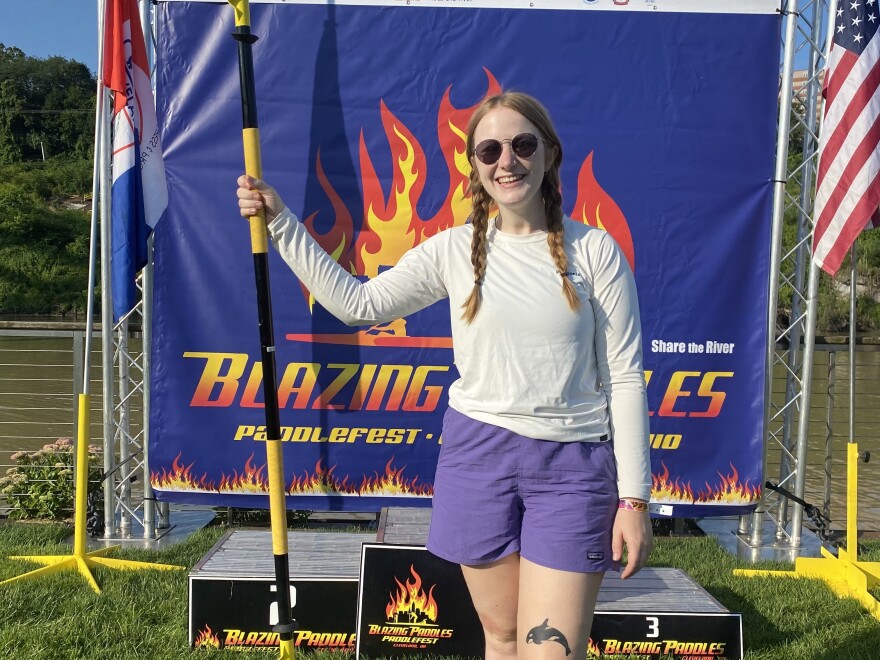I always say that the best introduction to a new city is through reporting: The people you meet, the communities you encounter, the stories you tell. And while all that’s true, I’ve also learned so much about Cleveland from exploring its waterways.
I moved from Akron to Cleveland in January, when we were deep in the throes of the long, bitter and gray winter that we Northeast Ohioans know all too well, like that weird, problematic relative that you don’t remember inviting but know will inevitably show up and hang around too long.
So by the time Cleveland defrosted and the clouds parted to unveil the sun, I was ready and eager to get outside. Being outdoors is among my favorite things: I love hiking, swimming, splashing around in the creek with my dog. And that was the biggest appeal of moving to Cleveland for me: access to wonderful Metroparks and nature, particularly Lake Erie.
Many roll their eyes or look at you with disgust when you talk about “Ohio beaches” or Lake Erie. But many who don’t live in the Midwest — or even those who do — don’t realize the utter beauty and magnitude of the Great Lakes and the rivers that feed them. In addition to the opportunities for water recreation, 20% of the entire world’s freshwater supply comes from the Great Lakes, an asset that will prove invaluable as climate change becomes increasingly challenging for coastal cities.

I grew up in the suburbs of Cincinnati, nearly four hours away from the lake. Every summer as a kid, we packed up the minivan and headed to the North Coast. My parents, both teachers likely in need of a reprieve from their three small children after a long summer together, would drop us off with our grandparents to stay on their boat for a week near Marblehead.
We would putz around Lake Erie during the day and eat Netty’s hot dogs and ice cream cones in the evenings. Some of my fondest childhood memories include leaping off the stern into the cool lake water, swimming, with that seemingly endless energy you have as an eight-year-old, to a nearby island and racing my brother barefoot down the scalding sand of a beach, daring the other to chicken out first.
Now that I live in Cleveland with the lake virtually in my backyard, I feel that nostalgia and playfulness returning. That’s why I started paddling, to chase that childhood joy of having fun for the sake of having fun, while also exploring a part of my new city that I feel often goes unappreciated.
I’d been wanting a paddleboard for years, and after finding a great deal on a sturdy inflatable one at REI (shoutout to my Toyota Corolla and little storage space), I was off.

This summer, I’ve taken every opportunity to be on the water. I’ve launched from Wendy Park on Whiskey Island and swung east around the historic, art deco Coast Guard Station into the Flats; from Merwin’s Wharf near Irishtown Bend, down the Cuyahoga past the Guardians statues carved into the sandstone pylons on the Lorain-Carnegie Bridge I cross every day on my way to work; from the Emerald Necklace Marina north through Rocky River, spilling out from below the rocky cliffs into Lake Erie.
Last weekend, I joined a very fun and welcoming community of paddlers at the annual Blazing Paddles Paddlefest hosted by Share the River, a group dedicated to promoting recreational activity on the Cuyahoga River and Lake Erie. Once a year, they offer races and a nearly nine-mile recreational paddle on the Cuyahoga beginning at Merwin’s Wharf, uninterrupted by jet skis, speed boats or freighters. It was a beautiful day, and I saw more of my city than I ever have from the roads above.

There’s an unrivaled sense of serenity sitting on a board, letting the waves rock you gently back and forth as you stare at the city skyline. It’s where Mother Nature and Man meet: humans trying to harness the power of our waterways, for our cities, for our commerce, for our recreation.
As the reporter who covers Cleveland's local government, I’m noticing an increased push for equitable lake access, and I think that’s a great thing. A saying I often hear is, “No one wastes water like Cleveland.” Despite our proximity to a thriving waterway system, our city was built to use the lake and river as a tool, not as a friend or amenity. Our fervent industrialism led to the infamous Cuyahoga River fire, and early urban planning has barred many communities, particularly less affluent ones, from having access to the shoreline. I’ve noticed a big disparity in who can access these waterways and from where.
There’s a want and need for it. Go to Edgewater Park on a nice summer day and chances are, the parking lots (which might be bigger than the park itself) are so packed, police officers are turning away lines of cars. There's no lack of lake, but there's a huge lack of lake access.
And local officials are paying attention. In my short time covering Cleveland, Mayor Justin Bibb has made sweeping commitments to make Lake Erie more accessible. So keep an eye on news coverage in the coming days, months and years, as the city and county debate working together to assemble a group to steer a master lakefront plan, stabilization efforts on Irishtown Bend for a future park begins and $20 million of Bibb’s American Rescue Plan spending for waterfront activation takes shape.
Because, in the end, we’re just guests here. These waterways existed long before we arrived and will be here long after we’re gone. They've taken care of us for so many years, so I'm thrilled we're looking to return the favor.
Where should I bring my board next? Send me an email and let me know.




